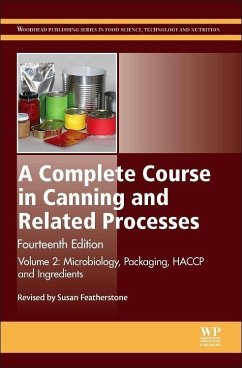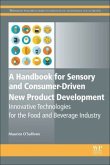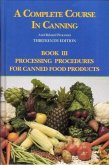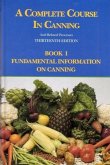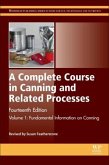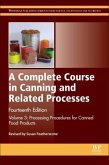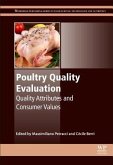A Complete Course in Canning and Related Processes
Volume 2: Microbiology, Packaging, Haccp and Ingredients
Herausgegeben:Featherstone, Susan
A Complete Course in Canning and Related Processes
Volume 2: Microbiology, Packaging, Haccp and Ingredients
Herausgegeben:Featherstone, Susan
- Gebundenes Buch
- Merkliste
- Auf die Merkliste
- Bewerten Bewerten
- Teilen
- Produkt teilen
- Produkterinnerung
- Produkterinnerung
A Complete Course in Canning is firmly established as a unique and essential guide to canning and related processes. Professionals in the canning industry and students have benefited from successive editions of the book for over 100 years. This major new edition continues that reputation, with extensively revised and expanded coverage. The three-title set is designed to cover all planning, processing, storage and quality control phases undertaken by the canning industry in a detailed, yet accessible fashion. Major changes for the new edition include new chapters on regulation and labelling…mehr
Andere Kunden interessierten sich auch für
![A Handbook for Sensory and Consumer-Driven New Product Development A Handbook for Sensory and Consumer-Driven New Product Development]() Maurice O'SullivanA Handbook for Sensory and Consumer-Driven New Product Development68,99 €
Maurice O'SullivanA Handbook for Sensory and Consumer-Driven New Product Development68,99 €![A Complete Course in Canning and Related Processes A Complete Course in Canning and Related Processes]() D L DowningA Complete Course in Canning and Related Processes153,99 €
D L DowningA Complete Course in Canning and Related Processes153,99 €![A Complete Course in Canning and Related Processes A Complete Course in Canning and Related Processes]() D L DowningA Complete Course in Canning and Related Processes153,99 €
D L DowningA Complete Course in Canning and Related Processes153,99 €![A Complete Course in Canning and Related Processes A Complete Course in Canning and Related Processes]() D L DowningA Complete Course in Canning and Related Processes153,99 €
D L DowningA Complete Course in Canning and Related Processes153,99 €![A Complete Course in Canning and Related Processes A Complete Course in Canning and Related Processes]() A Complete Course in Canning and Related Processes137,99 €
A Complete Course in Canning and Related Processes137,99 €![A Complete Course in Canning and Related Processes A Complete Course in Canning and Related Processes]() A Complete Course in Canning and Related Processes137,99 €
A Complete Course in Canning and Related Processes137,99 €![Poultry Quality Evaluation Poultry Quality Evaluation]() Poultry Quality Evaluation140,99 €
Poultry Quality Evaluation140,99 €-
-
-
A Complete Course in Canning is firmly established as a unique and essential guide to canning and related processes. Professionals in the canning industry and students have benefited from successive editions of the book for over 100 years. This major new edition continues that reputation, with extensively revised and expanded coverage. The three-title set is designed to cover all planning, processing, storage and quality control phases undertaken by the canning industry in a detailed, yet accessible fashion. Major changes for the new edition include new chapters on regulation and labelling that contrast the situation in different regions worldwide, updated information on containers for canned foods and new information on validation and optimization of canning processes, among many others.
Produktdetails
- Produktdetails
- Woodhead Publishing Series in Food Science, Technology and Nutrition
- Verlag: Elsevier Science & Technology / Woodhead Publishing
- Artikelnr. des Verlages: C2013-0-16339-8
- 14. Aufl.
- Seitenzahl: 376
- Erscheinungstermin: 5. Dezember 2014
- Englisch
- Abmessung: 228mm x 152mm x 229mm
- Gewicht: 670g
- ISBN-13: 9780857096784
- ISBN-10: 0857096788
- Artikelnr.: 59076583
- Herstellerkennzeichnung
- Libri GmbH
- Europaallee 1
- 36244 Bad Hersfeld
- gpsr@libri.de
- Woodhead Publishing Series in Food Science, Technology and Nutrition
- Verlag: Elsevier Science & Technology / Woodhead Publishing
- Artikelnr. des Verlages: C2013-0-16339-8
- 14. Aufl.
- Seitenzahl: 376
- Erscheinungstermin: 5. Dezember 2014
- Englisch
- Abmessung: 228mm x 152mm x 229mm
- Gewicht: 670g
- ISBN-13: 9780857096784
- ISBN-10: 0857096788
- Artikelnr.: 59076583
- Herstellerkennzeichnung
- Libri GmbH
- Europaallee 1
- 36244 Bad Hersfeld
- gpsr@libri.de
- Related titles
- Woodhead Publishing Series in Food Science, Technology and Nutrition
- Preface
- Introduction
- Part One. Microbiological hazards and process control
- 1. Microbiology of canned foods
- 1.1. Introduction
- 1.2. Key micro-organisms in food microbiology
- 1.3. Controlling the growth of micro-organisms
- 1.4. Important fungi in the food industry
- 1.5. Important bacteria in the food industry
- 1.6. Botulism
- 2. Spoilage of canned foods
- 2.1. Introduction
- 2.2. Types of spoilage of canned foods
- 2.3. Sources of contamination
- 2.4. Spoilage of canned vegetables
- 2.5. Microbiological standards for ingredients
- 3. Heat penetration determinations and thermal process calculations
- 3.1. Introduction
- 3.2. pH classification of canned foods
- 3.3. Thermal death time
- 3.4. HTST processing
- 3.5. Inoculated pack studies
- 3.6. HP determinations
- 3.7. Process establishment methods
- 3.8. Process calculation methods
- 3.9. Some causes of unreliable heat penetration data
- 3.10. HTST: a special type of heat penetration test
- 3.11. Summary
- 4. Optimising retort operations for canned goods
- 4.1. Introduction
- 4.2. Optimising the thermal process to reduce overprocessing
- 4.3. Changing the processing regime from low-acid sterilisation to pasteurisation
- 4.4. New thermal technologies
- 4.5. Converting batch processes to continuous processing
- 4.6. Summary
- 1. Microbiology of canned foods
- Part Two. Containers and ingredients
- 5. Metal containers for canned foods
- 5.1. Introduction
- 5.2. Types of cans
- 5.3. Can manufacture
- 5.4. Can lacquers
- 5.5. Tinplate can corrosion
- 5.6. Corrosion attributable to canning practices
- 5.7. Corrosion attributable to storage conditions
- 5.8. Can seam inspection
- 5.9. Storage and shipping of cans
- 5.10. Aluminium cans
- 5.11. Conclusion
- 6. Glass and plastic containers for canned foods
- 6.1. Introduction
- 6.2. Vacuum closures for glass - general characteristics
- 6.3. Factors effecting vacuum formation
- 6.4. 'Cold-water vacuum check' method
- 6.5. Vacuum closure application for glass containers
- 6.6. Auxiliary equipment
- 6.7. Closures for glass containers
- 6.8. Vacuum sealing
- 6.9. Coding
- 6.10. Processing glass containers
- 6.11. Packaging of food in plastic containers
- 6.12. Food contact and migration
- 6.13. Choice of plastic container
- 6.14. Sealing techniques
- 6.15. Warehousing and transportation
- 6.16. Plastic package recycle potential
- 6.17. Conclusion
- 7. Retortable flexible containers for food packaging
- 7.1. Introduction
- 7.2. Structure of flexible containers
- 7.3. Retort pouch manufacture
- 7.4. Quality assurance in retort pouch manufacture
- 7.5. Filling
- 7.6. Sealing
- 7.7. Processing/sterilization
- 7.8. Quality control tests for pouch laminate, pouch, and semirigid containers
- 7.9. Advantages of using retortable flexible containers
- 7.10. The disadvantages of flexible containers
- 8. Ingredients used in the preparation of canned foods
- 8.1. Introduction
- 8.2. Food additives
- 8.3. Salt, salt tablets, and combination tablets in canning
- 8.4. Carbohydrates in canning and preserving
- 8.5. Spices, essential oils, and oleoresins
- 8.5.2. Essential oils and oleoresins
- 8.6. Textured vegetable proteins
- 8.7. Monosodium glutamate
- 8.8. Water-soluble gums (hydrocolloids)
- 8.9. Emulsifiers (surfactants)
- 8.10. Colour additives
- 5. Metal containers for canned foods
- Related titles
- Woodhead Publishing Series in Food Science, Technology and Nutrition
- Preface
- Introduction
- Part One. Microbiological hazards and process control
- 1. Microbiology of canned foods
- 1.1. Introduction
- 1.2. Key micro-organisms in food microbiology
- 1.3. Controlling the growth of micro-organisms
- 1.4. Important fungi in the food industry
- 1.5. Important bacteria in the food industry
- 1.6. Botulism
- 2. Spoilage of canned foods
- 2.1. Introduction
- 2.2. Types of spoilage of canned foods
- 2.3. Sources of contamination
- 2.4. Spoilage of canned vegetables
- 2.5. Microbiological standards for ingredients
- 3. Heat penetration determinations and thermal process calculations
- 3.1. Introduction
- 3.2. pH classification of canned foods
- 3.3. Thermal death time
- 3.4. HTST processing
- 3.5. Inoculated pack studies
- 3.6. HP determinations
- 3.7. Process establishment methods
- 3.8. Process calculation methods
- 3.9. Some causes of unreliable heat penetration data
- 3.10. HTST: a special type of heat penetration test
- 3.11. Summary
- 4. Optimising retort operations for canned goods
- 4.1. Introduction
- 4.2. Optimising the thermal process to reduce overprocessing
- 4.3. Changing the processing regime from low-acid sterilisation to pasteurisation
- 4.4. New thermal technologies
- 4.5. Converting batch processes to continuous processing
- 4.6. Summary
- 1. Microbiology of canned foods
- Part Two. Containers and ingredients
- 5. Metal containers for canned foods
- 5.1. Introduction
- 5.2. Types of cans
- 5.3. Can manufacture
- 5.4. Can lacquers
- 5.5. Tinplate can corrosion
- 5.6. Corrosion attributable to canning practices
- 5.7. Corrosion attributable to storage conditions
- 5.8. Can seam inspection
- 5.9. Storage and shipping of cans
- 5.10. Aluminium cans
- 5.11. Conclusion
- 6. Glass and plastic containers for canned foods
- 6.1. Introduction
- 6.2. Vacuum closures for glass - general characteristics
- 6.3. Factors effecting vacuum formation
- 6.4. 'Cold-water vacuum check' method
- 6.5. Vacuum closure application for glass containers
- 6.6. Auxiliary equipment
- 6.7. Closures for glass containers
- 6.8. Vacuum sealing
- 6.9. Coding
- 6.10. Processing glass containers
- 6.11. Packaging of food in plastic containers
- 6.12. Food contact and migration
- 6.13. Choice of plastic container
- 6.14. Sealing techniques
- 6.15. Warehousing and transportation
- 6.16. Plastic package recycle potential
- 6.17. Conclusion
- 7. Retortable flexible containers for food packaging
- 7.1. Introduction
- 7.2. Structure of flexible containers
- 7.3. Retort pouch manufacture
- 7.4. Quality assurance in retort pouch manufacture
- 7.5. Filling
- 7.6. Sealing
- 7.7. Processing/sterilization
- 7.8. Quality control tests for pouch laminate, pouch, and semirigid containers
- 7.9. Advantages of using retortable flexible containers
- 7.10. The disadvantages of flexible containers
- 8. Ingredients used in the preparation of canned foods
- 8.1. Introduction
- 8.2. Food additives
- 8.3. Salt, salt tablets, and combination tablets in canning
- 8.4. Carbohydrates in canning and preserving
- 8.5. Spices, essential oils, and oleoresins
- 8.5.2. Essential oils and oleoresins
- 8.6. Textured vegetable proteins
- 8.7. Monosodium glutamate
- 8.8. Water-soluble gums (hydrocolloids)
- 8.9. Emulsifiers (surfactants)
- 8.10. Colour additives
- 5. Metal containers for canned foods

